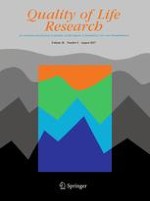22-03-2017 | Brief Communication
The “no problems”-problem: an empirical analysis of ceiling effects on the EQ-5D 5L
Gepubliceerd in: Quality of Life Research | Uitgave 8/2017
Log in om toegang te krijgenAbstract
Aim
To analyze the association between ceiling effects on the EQ-5D 5L and morbidity in a general population sample.
Methods
We used a cross-sectional sample of the German general population (n = 5007) to describe the frequency of health state “11111” and “no problems”-answers on the five single dimensions stratified by the number of diseases for which participants utilized health care during the last 6 months. For the five single dimensions we also used specific criteria to analyze their discriminative ability. A logit-model was applied for a multivariate analysis of ceiling effects.
Results
31% of participants reported the health state “11111.” This percentage strongly decreased with increasing morbidity, down to 4.9% if four or more diseases were present. The dimensions “mobility,” “usual activities,” and “pain/discomfort” showed good discriminative abilities. The dimensions “anxiety/depression” and “self -care” were able to discriminate between different levels of morbidity, but nevertheless showed strong ceiling effects, in particular “self-care.”
Conclusion
When analyzing ceiling effects of the EQ-5D 5L, one has to draw attention to morbidity since high proportions of participants indicating the best health state might result from being healthy regarding the dimensions assessed by the EQ-5D, in particular in general population datasets.
